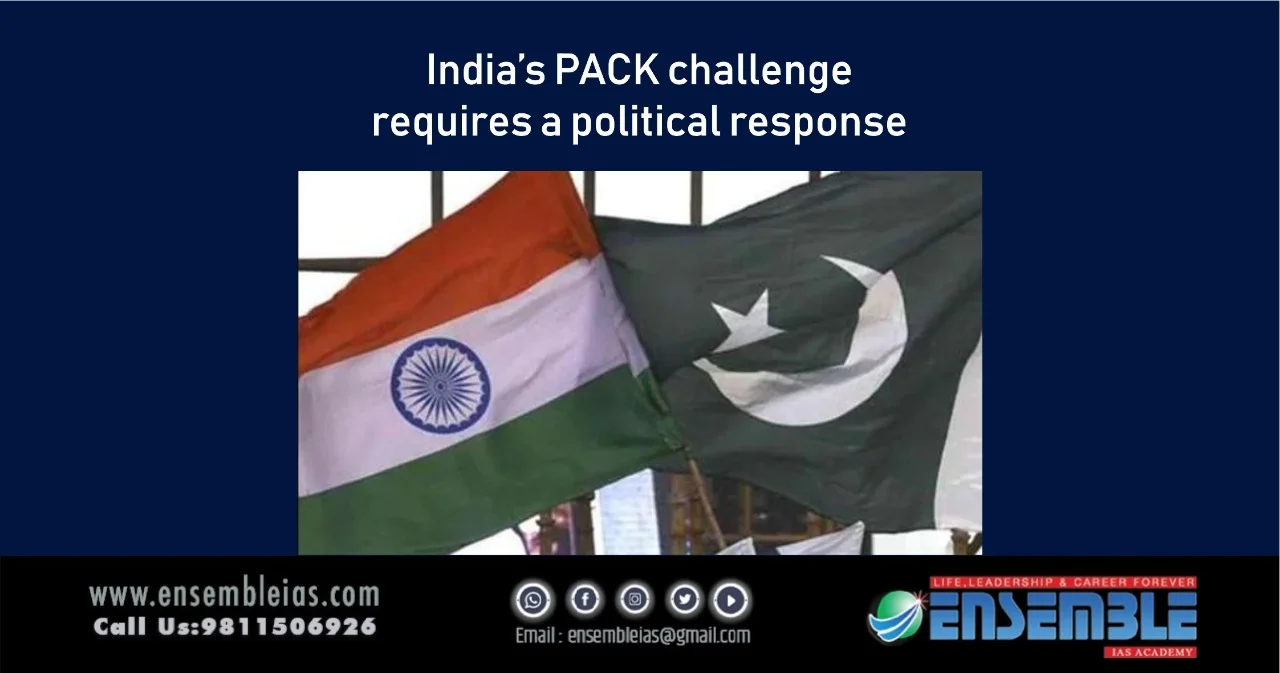India’s PACK challenge requires a political response
India’s PACK challenge requires a political response: Call it PACK — a strategic spread of interlinked geographies, comprising Pakistan, Afghanistan, China and Kashmir. With territorial disputes, political instability, religious radicalism, popular aspirations and great power dynamics as key issues, PACK is forcing a long game on India. Playing it well requires both resources as well as a concerted political approach at the top level. The latter is key. How is New Delhi faring?
To buy our online courses: Click Here
Pakistan is speaking a new language of geoeconomics and a trade-fronted regional policy. This merits cautious interest from New Delhi, indications of which are evident. The aggressive rhetoric that preceded and followed the August 5, 2019, decisions died down as the ceasefire announcement neared. Oddly, the military-logistical joint statement, released on February 25, also referred to the two director general of military operations (DGMOs) agreeing to “address each other’s core issues and concerns which have propensity to disturb peace and lead to violence”. This was a political element, and it is not clear why it was inserted there.
evertheless, optics and remarks suggest something is in the works. On his visit to the United States (US) last month, external affairs minister (EAM) S Jaishankar mentioned the “bigger issues” with Pakistan that need addressing, noting that “everybody hopes for the best”.
So is a fresh Pakistan policy in the offing? With stray unofficial remarks and no political statement, we know very little while the Indo-Pak bazaar of speculation flourishes. Compare this with Pakistan, where Prime Minister (PM) Imran Khan has clearly laid out the conditions for engagement with India. Why the opacity at the top level in New Delhi? Is there a concern about a backlash from domestic actors? Or is it because there is no desire to risk the embarrassment that followed the Lahore touchdown of December 2015?
In Afghanistan, the Taliban consider themselves victorious. The graph of their recent gains suggests that they will likely shape the nature of the Kabul regime within the coming year. To India, Afghanistan is a stellar example of its commitment to political and societal modernisation of a country carried out with voluntary participation of its citizens. Given this, India’s stake in the nature of the coming Afghan regime is robustly legitimate. New Delhi has fittingly spelt out its preference — a constitutional and democratic regime that protects the rights of women and minorities. Jaishankar has articulated this position, saying that the gains of two decades must not be lost to political expediency.
The position is politically bold and desirable. And to say that it befitted a stronger articulation or reiteration from the PM in no way minimises the status and standing of EAM. But the informed Indian citizen must wonder why it hasn’t been coming. Is it because this endorsement of a liberal democracy abroad — with an unequivocal commitment to minority rights — sits oddly with the project at home? Isn’t it more urgent given reports that India has begun engaging with the Taliban? New Delhi may also want to consider that its stated concern for the rights of South Asian minorities — a central tenet of liberalism — when contrasted with what is widely perceived to be the a systematic marginalisation of its own minorities, erodes its standing.
On Kashmir, the decisions of August 2019 were about securing an ideological goal. Their impact on the security of national interest will become clear in the coming years, even as Kashmir moves from lockdown to lockdown. Generic terms such as development, peace and integration with the rest of the country are understandable, but it is not clear what New Delhi considers a new and sustainable Kashmiri equilibrium, one where all Kashmiris feel included, within the larger PACK matrix.
However, it is on China that the trajectory of the political approach and leadership has been most telling. Assurance has been given that no territory would be lost on the government’s watch. Bravery of soldiers has been rightly praised in addresses to citizens. Regime partisans speak of India having stared China down. All this against the backdrop of the fact that we don’t even have a complete official account of what has transpired on the ground.
On the China policy, the core problem remains unaddressed — the collapse of bilateral political understanding forged at the highest level in Ahmedabad, Wuhan and Mamallapuram. Instead, we have seen a tactical approach focused on the eastern Ladakh situation articulated and/or executed by the national security, military, and diplomatic establishments. In the seeming absence of a political approach and leadership, bilateral relations drift while new facts advantageous to the Chinese are reportedly getting entrenched on the ground.
Also Read: अब सैटेलाइट से भी पहले चल जाएगा चक्रवाती तूफान का पता, भारतीय वैज्ञानिकों ने तैयार की नई टेक्नोलॉजी
Aversion to political risk and hedging in the face of flux are common to leaderships. But the opportunities and challenges presented by PACK demand a concerted approach and visible leadership at the top political level. With over a year gone, it is time for PM Narendra Modi to set out his government’s efforts at securing India’s national interest vis-à-vis China. The Afghan position, if articulated by him, would relieve many at home and abroad. Risks with Pakistan won’t be new, but they shouldn’t cost him much given the popular support. And everyone needs an inclusive and representative Kashmir vision.




